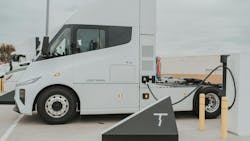Windrose and Terawatt enhance electric fleet efficiency with dual charger testing
Windrose Technology and Terawatt Infrastructure have taken a step forward in their partnership, completing a series of interoperability tests at Terawatt's flagship site in Rancho Dominguez, California. These tests demonstrated Windrose's dual gun charging capability, delivering more than 650 kW using two 350 kW chargers from Delta Electronics. The test achieved a 240-mile range charge in about 40 minutes, proving readiness for the next generation of high-utilization commercial electric fleets.
Windrose and Terawatt are now working on deeper software integration, connecting Windrose's vehicle systems with Terawatt's site and energy management platforms. This effort will enable more intelligent charging, increased uptime, and improved total cost of ownership for fleet customers operating at scale.
"This partnership is about more than performance metrics; it's about delivering real-world solutions to the fleets driving the energy transition," Wen Han, founder, chairman, and CEO of Windrose Technology, said. "Together with Terawatt, we're aligning vehicle and infrastructure platforms in a way that scales efficiently and delivers immediate value to customers."
See also: DOE awards millions of dollars to fund heavy-duty EV charging projects in California, Arizona, Utah
In addition, Windrose and Terawatt are collaborating on joint customer programs to support the rapid electrification of heavy-duty fleets across the U.S. These programs include local customer deployments at Terawatt's live charging hubs in Southern California, as well as long-haul deployments at future sites along Terawatt's I-10 corridor between Los Angeles, California, and El Paso, Texas.
"Windrose builds the kind of vehicles that are going to define the future of freight," Neha Palmer, CEO of Terawatt, said. "By combining their next-generation trucks with our infrastructure, and sites designed for quick charging with the least disruption to operations, including pull-through stalls that accommodate trailers, we are unlocking new electric lanes in Southern California and beyond. The deeper our collaboration goes—from power to software to site design—the better we serve our customers."
Additional joint testing and customer pilots are planned throughout the summer, with deployments expected to accelerate in late 2025.
